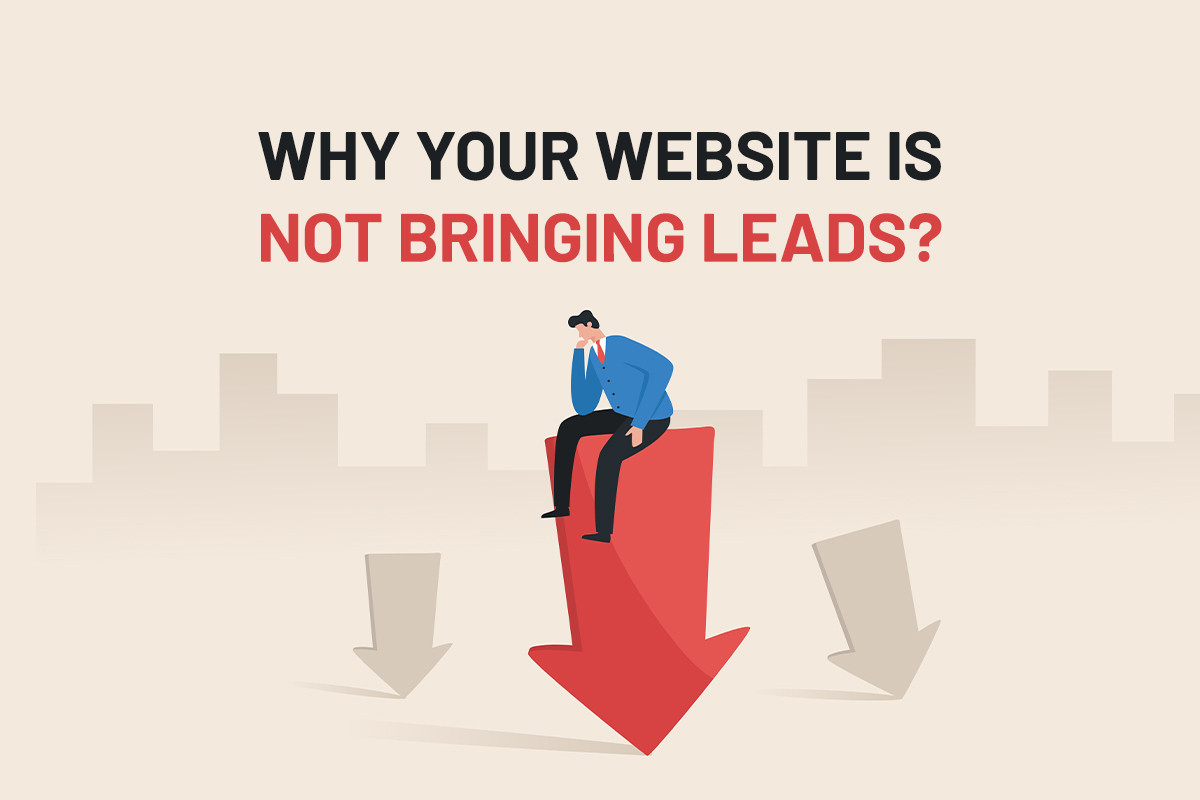
Why your Website is not bringing leads? | Understand & Improve
In today’s world, the website is much more than just an online presence; it’s a pivotal part of its identity and a crucial element in the marketing ecosystem. Gone are the days when a website was a luxury or an afterthought. Now, it’s a necessity. The democratization of web development, largely due to the advent of skilled freelancers, has made it financially feasible for almost every business, small or large, to have an online presence. However, this accessibility has led to a crowded and competitive digital space, where simply having a website is no longer enough to distinguish a business.
The primary goal of a website extends beyond showcasing a brand or its offerings. It is an indispensable tool for generating leads – potential customers who show interest in your product or service. However, many businesses face a common conundrum: despite having a visually appealing website, they struggle to convert their web traffic into tangible leads. This issue often stems from a lack of understanding of what makes a website truly effective in today’s digital age.
A lead-generating website is not just about aesthetics or content; it’s a symphony of various elements working in harmony. The first aspect is the ability to attract traffic. This is where the art and science of Search Engine Optimization (SEO) come into play. SEO is not just about peppering your content with keywords; it’s about structuring your website in a way that search engines find it credible and worthy of a higher ranking.
Once you attract visitors, the next challenge is to accommodate them. This is where bandwidth and hosting become crucial. Many businesses opt for cheaper hosting options like shared hosting with unmetered bandwidth covering fair usage policy to cut costs, not realizing that limited bandwidth can lead to slow loading times and a poor user experience, especially when traffic spikes.
Furthermore, the structure of the website plays a crucial role. A well-structured website is not only aesthetically pleasing but also intuitive and user-friendly. It guides the visitor naturally through the pages, leading them to the information they seek and encouraging interaction. The layout, the navigation, the placement of call-to-action buttons – every element matters.
Lastly, having a website that is SEO-optimized is key. SEO is not a one-time task but an ongoing process that ensures your website stays relevant and visible in the ever-changing landscape of search engine algorithms. A website that is not SEO-optimized is like a billboard in a desert – it exists, but hardly anyone sees it.
In essence, creating a website that can consistently generate leads requires a blend of technical know-how, strategic planning, and an understanding of the ever-evolving digital trends. In this article, we will explore the common pitfalls that hinder websites from generating leads and provide insights on how to transform your website into a lead-generating powerhouse.
1. The Pitfall of Non-Original Content
In the vast expanse of the internet, content is not just king; it’s the currency of engagement and relevance. The issue of non-original content on a website is akin to building a house on a shaky foundation – it may stand for a while, but eventually, it will falter. This analogy holds particularly true when considering the impact of non-original content on lead generation and SEO performance.
Non-original content, often termed ‘duplicate content’, refers to blocks of content that are either completely identical or very similar to content found elsewhere on the web. This can range from copying and pasting content from other websites to slightly modifying existing content to make it appear unique. The implications of using non-original content are multifaceted and can be detrimental to a website’s success in numerous ways:
Search Engine Penalties:
Search engines like Google prioritize unique, high-quality content. Their algorithms are designed to detect and penalize websites with duplicate content. This can result in lower search rankings, which in turn reduces the visibility of your website to potential customers. For example, a business blog that repurposes popular articles from other sites might find its pages relegated to the lower ranks of search results, thus missing out on valuable organic traffic.
Diminished User Engagement:
Users seek fresh and original content that provides value. When they encounter reused or repetitive information, it diminishes their engagement and trust in the website. This is crucial because user engagement is a key factor in converting visitors into leads. For instance, if an educational website merely aggregates content from other sources without adding any original insights or perspectives, it will struggle to build a loyal audience or encourage users to sign up for its services.
Brand Impact and Credibility:
Original content reflects a brand’s voice, expertise, and value proposition. By using non-original content, a business risks diluting its brand identity and losing the opportunity to establish itself as a thought leader in its field. For example, a company specializing in sustainable products but using generic, widely available content on environmental topics will fail to differentiate itself in a crowded market.
Legal Consequences:
Replicating content without permission can lead to legal issues. Copyright laws protect intellectual property, and violation of these laws can result in fines and legal battles. A business must ensure that the content on its website is either original or properly licensed.
Lack of SEO Customization:
Non-original content is not tailored to a business’s specific SEO strategy. It lacks the necessary keywords and structure to rank well for specific search queries relevant to the business. For example, a local bakery using generic content about baking will not rank as well for local search queries as it would with original content focused on its specific location and offerings.
To avoid these pitfalls, businesses should invest in creating original, high-quality content that resonates with their target audience and aligns with their SEO strategy. This might involve crafting informative blog posts, insightful articles, engaging videos, or compelling infographics that not only attract but also retain visitor interest. This approach not only improves SEO rankings but also positions the business as an authoritative and trustworthy source in its industry, thereby enhancing its potential to generate leads.
2. Overlooking Technical SEO
Technical SEO, often overshadowed by its more well-known counterparts – onsite and offsite SEO, is a critical pillar in the triad of comprehensive search engine optimization. Neglecting technical SEO is like building a beautiful store with no roads leading to it; no matter how attractive or well-stocked it is, if people can’t easily find and access it, it won’t generate the traffic or sales desired.
Technical SEO refers to the optimization of website infrastructure, ensuring that search engines can effectively crawl, interpret, and index the content. This process involves a myriad of elements, each playing a vital role in enhancing a website’s visibility and usability:
Website Speed and Performance:
Search engines favor websites that load quickly and perform smoothly. Slow loading times not only frustrate users but also harm search engine rankings. For instance, an online retailer with high-resolution product images may face slow loading times if these images aren’t properly optimized, leading to a higher bounce rate and lower search ranking.
Mobile Responsiveness:
With the majority of internet traffic now coming from mobile devices, having a mobile-responsive website is non-negotiable. Google’s mobile-first indexing means that the mobile version of your website is primarily used for indexing and ranking. A business website that isn’t mobile-friendly is likely to be penalized in search rankings, reducing its visibility to potential leads.
Crawlability and Indexing Issues:
The ability of search engines to crawl and index a website is foundational to its visibility. Technical issues like improperly configured robots.txt files or faulty sitemap.xml files can prevent search engines from accessing and indexing the website content effectively. For example, an e-commerce site with a complex structure might not be fully indexed if the sitemap is not well-organized, leading to some products not appearing in search results.
Website Security (HTTPS):
Security is a top priority for search engines. Websites that use HTTPS are favored over those that don’t because they provide a secure connection. An informational website that hasn’t migrated from HTTP to HTTPS could be losing trust from both visitors and search engines, impacting its potential to generate leads.
Structured Data and Schema Markup:
Implementing structured data helps search engines understand the content on your website. This can enhance the appearance of your website in search results with rich snippets, which can improve click-through rates. For instance, a recipe blog that uses schema markup for its recipes may have its recipes displayed directly in search results, attracting more visitors.
URL Structure and Navigation:
A clear and logical URL structure, along with intuitive navigation, is crucial for both user experience and SEO. Complex or unclear URL structures can confuse users and search engines, negatively impacting the site’s usability and rankings. For example, a service-based business with a convoluted URL structure can make it difficult for potential clients to find specific services, reducing the likelihood of lead conversion.
3. Issues with Bandwidth on Shared Hosting
Bandwidth in the context of web hosting is the amount of data that can be transferred between your website, users, and the internet within a given time frame. Understanding its significance and the common issues associated with shared hosting is crucial for businesses aiming to optimize their websites for lead generation.
Shared hosting, where multiple websites are hosted on a single server and share resources like bandwidth and storage, is a popular choice for many businesses due to its cost-effectiveness. However, this arrangement can lead to several bandwidth-related issues that directly impact website performance and user experience:
Limited Resource Allocation:
In shared hosting, the server’s resources, including bandwidth, are divided among all the websites hosted on that server. When one or more of these websites experience a surge in traffic, it can consume a disproportionate amount of the server’s available bandwidth. This leaves other websites on the same server with insufficient resources, leading to slow loading times or, in extreme cases, website downtime. For instance, during peak sales periods, an e-commerce site might struggle with performance issues if another site on the same server is experiencing high traffic.
Unexpected Traffic Spikes:
Many businesses do not anticipate sudden spikes in traffic, which can be caused by marketing campaigns, seasonal trends, or viral content. Shared hosting often fails to accommodate these spikes, as the sudden increase in data transfer can exceed the allocated bandwidth limit. This can result in slow website performance or an outright failure to load, both of which are detrimental to user experience and the website’s ability to convert visitors into leads.
Search Engine Ranking Impact:
Website speed and uptime are critical factors in search engine rankings. Slow-loading websites or those that frequently experience downtime are penalized by search engines, resulting in lower rankings. This diminished online visibility directly affects the volume of organic traffic to the site, thereby reducing the potential for lead generation. For example, a business blog hosted on a shared server might lose its ranking due to slow loading times, making it less visible to its target audience.
Security Concerns:
Shared hosting can also pose security risks. If one website on the server is compromised, there is a potential for other sites on the same server to be affected. This risk can harm a business’s reputation and lead to a loss of visitor trust, which is essential for converting visitors into leads.
Scalability Issues:
As businesses grow and their website traffic increases, the bandwidth needs also grow. Shared hosting may not provide the scalability required to accommodate this growth seamlessly. This can hinder a business’s ability to expand its online presence and handle increased traffic effectively, which is essential for continuous lead generation.
To mitigate these issues, businesses should consider their hosting options carefully. Upgrading to a dedicated server or cloud hosting solution, although more expensive, provides greater control over resources, including bandwidth, and offers better scalability and security.
4. Ineffective Lead Magnets
Lead magnets are an essential tool in the digital marketer’s arsenal, designed to capture the contact information of potential leads. However, when these magnets are not effectively crafted, they fail to engage visitors and convert them into leads. Understanding the common pitfalls and strategizing to avoid them is crucial for any business looking to enhance its lead-generation efforts.
Lack of Value Proposition:
The primary reason for the ineffectiveness of many lead magnets is their failure to offer a compelling value proposition to the target audience. For a lead magnet to be successful, it must provide something of significant value that resonates with the needs and interests of the potential customers. For instance, a generic newsletter sign-up is often less effective than an exclusive industry report or a free webinar that offers actionable insights.
Misalignment with Audience Interests:
Another critical issue is the misalignment of the lead magnet’s content with the interests or needs of the target audience. A lead magnet must be relevant to the audience segment it aims to attract. For example, a lead magnet offering beginner-level tips might not appeal to an audience of advanced practitioners in a specific field. Understanding the audience persona and tailoring the lead magnet accordingly is vital.
Overcomplication and Poor Accessibility:
Sometimes, lead magnets are too complex or demanding, which can deter potential leads. The process of accessing the offered value should be straightforward and user-friendly. For example, a multi-step sign-up process or a lead magnet that requires extensive personal information can dissuade visitors from engaging. Simplicity and ease of access are key to maximizing conversions.
Ignoring Analytics and Feedback:
Continuously measuring the performance of lead magnets and adapting based on data and user feedback is crucial for success. Many businesses fail to track the performance of their lead magnets, missing out on insights that could help refine their strategy. Regularly reviewing metrics like conversion rates and user engagement can provide valuable information to enhance the effectiveness of the lead magnet.
5. Lack of Promotion on Google and Social Media
A common oversight is failing to promote the website through Google ads and social media platforms. Active promotion increases visibility and directs traffic to your website. A business not leveraging these platforms misses out on a vast audience. For example, a targeted Facebook ad campaign can drive significant traffic to a website, increasing the likelihood of lead generation.
6. High Loading Time Due to Outdated Templates
Websites using outdated templates often suffer from high loading times, negatively impacting user experience and SEO.
High loading times can be a significant barrier to effective online engagement, often leading to increased bounce rates and reduced conversions. One of the primary culprits for slow website performance is the use of outdated templates. Understanding and addressing this issue is essential for businesses aiming to maintain an efficient, lead-generating online presence.
Impact on User Experience:
Research suggests that a delay of even a few seconds can lead to user frustration and abandonment of the site. For example, an outdated template with heavy, complex coding can cause an e-commerce site to load slowly, deterring potential customers who might switch to a competitor with a faster, more responsive website.
Search Engine Ranking Penalties:
Search engines like Google consider page loading speed as a ranking factor. Websites with slower loading times are likely to be ranked lower in search results. This decreased visibility means fewer visitors and, consequently, fewer leads. A business website using an outdated template may not only lose existing traffic but also fail to attract new visitors due to poor search engine visibility.
Compatibility Issues with Modern Technologies:
Outdated templates often lack compatibility with modern web technologies and browsers. This incompatibility can lead to incorrect website rendering and functional glitches, further increasing loading times. For instance, a website using an old template might not display correctly on the latest version of a popular web browser, leading to increased loading times and a broken user interface.
Inefficient Mobile Performance:
With the increasing predominance of mobile internet usage, a website’s performance on mobile devices is crucial. Outdated templates are often not optimized for mobile responsiveness, leading to longer loading times on smartphones and tablets. This lack of optimization can severely hamper a website’s ability to attract and retain mobile users.
Increased Server Load and Resources:
Websites with outdated templates tend to require more server resources to load. This increased load can strain the hosting server, especially in a shared hosting environment, further contributing to slow loading times. For a small business website on a limited budget, this inefficiency can lead to additional costs or the need to upgrade hosting plans prematurely.
Security Vulnerabilities:
Older templates may not follow the latest web security standards, making the website susceptible to cyber threats. These security gaps can indirectly impact loading times if the website becomes a target for malicious activities like DDoS attacks.
To overcome these challenges, it’s imperative for businesses to regularly update their website templates and ensure they are in line with current web standards. This involves creating templates that are lightweight, mobile-responsive, and regularly updated for compatibility and security. Additionally, optimizing website elements like images and scripts can significantly reduce loading times. For instance, a business can use modern image formats like WebP for high-quality visuals with lower file sizes, aiding in faster loading.
By addressing these key areas, businesses can transform their websites into powerful tools for generating leads, driving growth, and achieving success in the competitive digital marketplace. If you want to develop or revamp your website with experts, then readHyrrokkin’s Web Development Guide.






